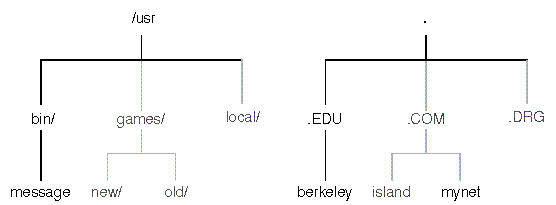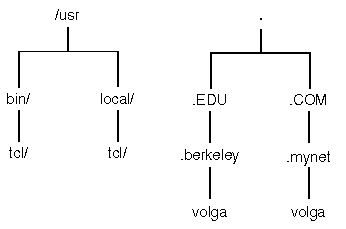DNS domain and hostnames
DNS domain names are structured as a listing,
from left to right, of the
domain name space from the host to the root. For example, in the DNS
name volga.your_company.COM., the host, volga, appears in the
domain your_company.COM, which is a subdomain of COM,
which is a domain under the root.
Specifying the root domain is optional; when indicated it is shown as a
trailing dot (.).
This naming structure is similar to UNIX filenames in the following ways:
location-
Each name gives its location in a tree. For example: the filename
/usr/bin/message and the domain name your_company.COM.:

uniqueness-
Each name need only be unique within its portion (domain or directory)
of the tree. For example: two files named tcl and two hosts
named volga:

relativity-
Each name can be relative or absolute (fully qualified).
A fully qualified domain name ends at the root domain, indicated by a
trailing dot (example: volga.your_company.COM.). A domain name minus
the dot may be seen as a relative domain name
(example: volga.your_company). Again, parallels exist with the
UNIX filesystem, in which the file /usr/bin/tcl may be
indicated as /usr/bin/tcl (its absolute name) or
simply tcl (its relative name).
Next topic:
The Internet domain structure
Previous topic:
DNS domains and zones
© 2007 The SCO Group, Inc. All rights reserved.
SCO OpenServer Release 6.0.0 -- 05 June 2007



